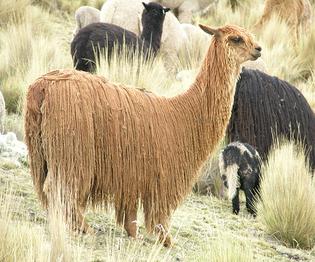Nordicalpaca
Alpacas.
Alpacas originated on the high Andean Plateau and mountains of South America. They were a cherished treasure of the ancient Incan civilization and played a central role in the Incan culture. Alpacas were first imported to the North America in 1984. Alpacas are now being successfully raised and enjoyed throughout North America and abroad. There are two types of alpacas – the Huacaya: the most common, has a very crimpy fleece that gives them a “fluffy” appearance and the Suri: more rare, having very silky hair-like fiber which grows in tight spirals and drapes down into pencil locks.
Alpacas eat very little food (approximately 1 cup of grain twice a day and ½ - 1 pound of free choice hay or pasture per animal) and therefore require only a small amount of acreage per animal, alpacas are herd animals so they have to be kept in groups of two or more. Veterinary costs for alpacas are minimal. Besides their endearing qualities of warmth, friendliness, and trainability, they have an enduring quality of strength and toughness. Coming from the rugged Andes makes life on the farm a piece of cake...for your alpaca and for you!
Alpacas are friendly and very curious which makes it hard to resist being around them. Alpacas have no teeth on top in the front and do not bite; they have soft feet with pads under their toe nails, and a non-aggressive personality. This makes them an adorable farm animal or pet. That isn’t saying that you might get caught in the crossfire of an alpaca spitting or a kick from behind. Unless they feel challenged, spitting is generally saved to make ‘their’ point to fellow alpacas. Alpacas are very social animals and communicate to each other with humming noises, body and head movements. They also have a distress call to alert the rest of the herd of danger.
Alpacas description.
•Birth weight is usually around 16 to 21 pounds. Crias (baby alpaca) can most often stand and nurse within 2 hours. Infant mortality is very low.
•Alpaca’s average lifespan ranges 15-25 years.
•Alpaca’s average height is 36 inches at their shoulders.
•Alpacas weigh on the average: 100-200 pounds (1/2 to 1/3 the size of llamas).
•There are two breeds of alpaca: Huacaya, the most common, has a very crimpy fleece that gives them a "fluffy" appearance and Suri: more rare, having a very silky hair-like fiber which grows in tight spirals and drapes down into pencil locks.
•An Alpaca that turns one year old is called a Tui.
•Female Alpacas are pregnant for on average 345 days and only produce one Cria at a time. Twins are very rare. Birthing is relatively easy and trouble free and 99% of the time is in daylight hours.
•Female alpacas (hembra) can be bred back as early as 2 weeks after parturition and can start breeding as early as 14 months of age.
•Male alpacas (machos) can begin to breed between 2-3 years of age.
• Alpacas are induced ovulators and can be bred throughout the year.
•Alpacas prefer outdoors to being cooped up in a barn.
•Alpacas do not require special fencing or a lot of acreage (5 to 15 animals/acre).
•Other than Shearing and the usual de-worming and vaccinations, Alpacas require little else.
•Toenails and teeth may occasionally need trimming.
•They produce fibre that is fine as cashmere, soft, silky and much warmer than sheep’s wool.
•Alpacas come in a whole range of colors, 22 basic colors and then 250 different shades.
•Alpacas are shorn once a year in the spring.
•Shearing involves conventional sheep-shearing equipment but the animal is restrained. The annual yield per animal is around 5lbs. With top animals reaching 10lbs.
•The first fleece or Cria fleece commands a premium because of its extra fineness and crimp.
•Alpaca fleece is 3x warmer than sheep wool and 7x stronger.



